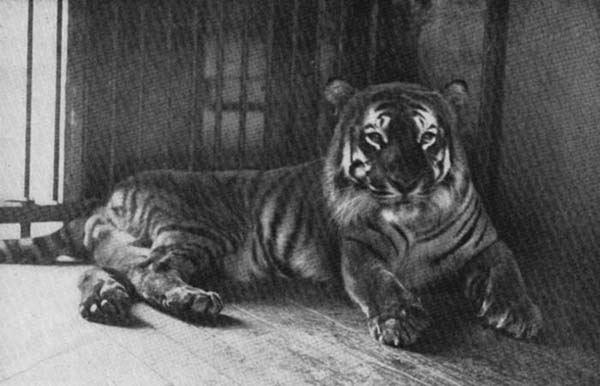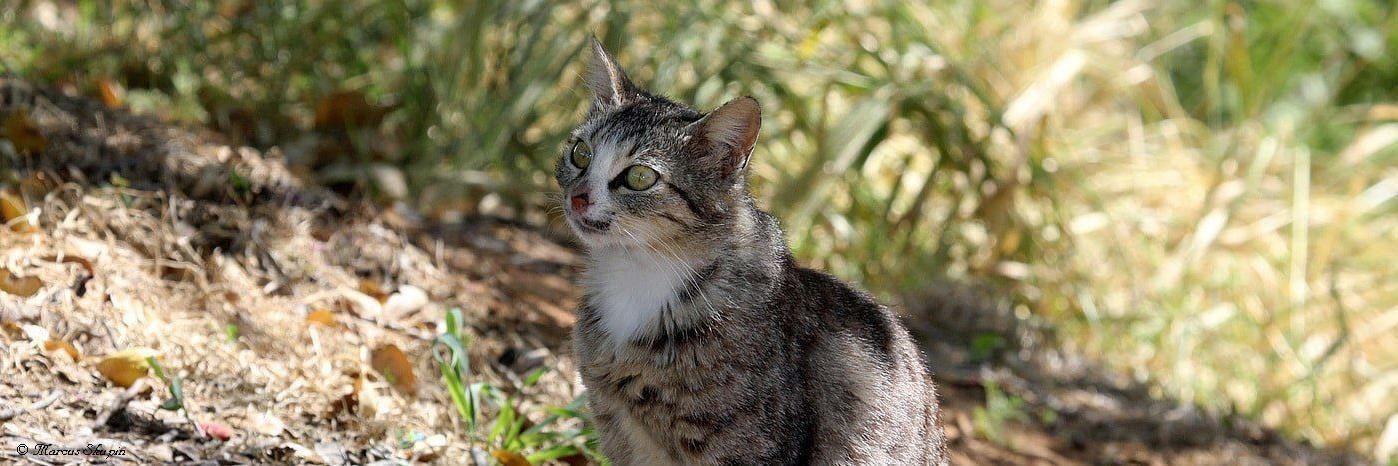Chapter VI
The Tiger
The tiger lives in most of the countries along the south coast of Asia, that is, all the way from Persia to China. Some tigers are also found in the northern countries of Asia, such as Siberia; but there are very few of them there. And, of course, these few tigers in the cold northern countries of Asia are a little different from those in the hot southern countries. For the tigers in the cold countries have thick fur on their skin, and a layer of fat under their skin just to keep them warm. So they are too fat to be as muscular and active as the slim and lithe tigers that live in the hot countries in the south of Asia.
Now please remember one thing more about the dwelling place of the tiger: there is no tiger in Africa. Even clever people do not always know that. When ex-President Roosevelt went on a hunting trip to Africa a few years ago, he shot many wild and ferocious animals there, and some newspapers said that he had shot several tigers.[74]
That was a mistake. The animals that he shot were leopards, not tigers. You can at once tell the difference between a leopard and a tiger: a leopard is spotted, but a tiger is striped. I shall tell you all about that presently.
Even as regards the habits and character of the tiger, people often make mistakes. There is no animal that has been so much abused as the tiger. Most people call the tiger a "cruel" and "bloodthirsty" animal.
But that is not true. By "bloodthirsty" people usually mean that the tiger kills his prey for the mere sake of killing, and that he kills more animals than he can eat, just for the mere fun of killing.
That is not true. A tiger is not really "bloodthirsty" in that way, as I shall explain to you presently. A tiger never kills for the mere fun of killing. Some men and some naughty boys do that! They think it great sport to kill harmless wild animals, which they cannot possibly eat or use in any way; and some naughty boys kill frogs and lizards and other small animals, just for the mere "fun" of killing, as they call it.

Tiger
The Wonders of the Jungle
A tiger never does that and he is supposed to be the worst animal of all! For one thing, a tiger is not such a fool as to kill his prey for the mere sake of killing. Men formerly ate the flesh of the American bison, or buffalo, as it was generally called. But then they killed off whole herds of these buffaloes. So now there are no more buffaloes left for food in those places. A tiger is wiser. He does not destroy his own food supply needlessly.
People are also wrong when they say that a tiger is "cruel," and that he tortures his prey before killing it outright. That is not true of the tiger. In fact, hardly any animal is needlessly cruel, as some men and naughty boys are for instance, naughty boys who torture frogs and lizards and then kill them.
It is true that a tigress does worry her prey before killing it. But why does she do so? Simply to teach her cubs how to catch and kill the prey, so as to provide food for themselves when they grow up. I shall explain that fully presently. So please remember this once for all: hardly any animal is needlessly cruel or bloodthirsty.
"But a cat does worry a mouse, before killing it," you may object. "Is not that needless cruelty?"
That seems quite true. But there is a reason for it: the cat first began to do that to teach her kittens how to catch mice, when she was a wild animal in the fields. Once upon a time the cat was a wild animal, but now people have tamed it into a domestic animal. So the cat still retains some of its wild habits.
But you will understand all that when I tell you more fully about the tiger, which is the largest and strongest animal of the Cat Tribe.
The Life History of the Tiger Family
I shall describe to you the actual life of a tiger family in the jungle. A tiger family consists of the father, the mother, and from two to four cubs. Three is the usual number of children that a tiger and tigress have.
When the cubs are only a few days old, they are quite helpless. So the mother stays with them in the den, while the father goes in search of food. The den is usually a hollow under a large tree.
If the father tiger catches a prey which he can carry, such as a deer, he brings it home with him. Then he and the tigress eat it together.
But if the prey is too large to carry, such as a bullock or a buffalo? Then the tiger first eats a good portion right after catching it. Then he comes home to the den and sends out the tigress to eat her share, while he stays home in the den and takes care of the cubs.
But here is something for you to think of. In sending the tigress out to eat her share of the prey, the tiger must tell her where the prey is lying; otherwise she might go the wrong way. Why? Because the prey might be lying a mile or more from the den, so that she could not possibly trace it merely by its scent. And the prey might have been caught in any direction, especially if the tiger had to chase it or stalk it for a long distance. So nobody could tell beforehand in what direction a tiger might catch its prey.
The tigress could not merely follow the tiger's paw marks to get to the prey, as the tiger may have gone out several times that day or the day before; and so there would be several lines of paw marks, and she would have to search very long by following all the paw marks in turn. Yet she always takes the right direction, and gets to the prey quickly. Hunters in the jungle have found that out. How does she do it?
The only way to explain it is this the tiger tells her where the prey has been caught and is now lying. That is what hunters believe from the actual facts they have observed. Then that shows that animals have a method of communicating with one another. Of course they do not use our words. They must have words or sounds, or even signs, of their own.
Now I shall go on with the tiger family. The cubs, of course, drink their mother's milk. They do that till they are three months old.
But meanwhile, when they are six weeks old, they can walk and trot. They are then very playful, and they leap and gambol and tumble over one another.
They are then able to go about with their father and mother for a short distance. So if food gets scarce for the tiger and tigress, they leave their old den altogether, and go to live elsewhere in the jungle where food may be more plentiful.
In this house-moving the cubs can trot behind their father and mother for a mile or two. Then, for fear of tiring the cubs, the tiger and tigress scoop a hollow under a tree, and place them there. The tiger and tigress go on ahead till they find the new home. Then they come back to fetch the cubs.
If the cubs are now two months old, the father and mother need have no fear in leaving them for a few hours. So in their new home the tigress may go hunting with the tiger every day.
If food gets very scarce, the tiger goes out alone for a long distance for two or three days at a time. In his absence, the tigress makes a short trip from time to time in another direction, in case any other kind of food may by chance be found there.
Tigers prefer to eat deer or antelope, just as you may prefer to eat roast turkey. But if tigers cannot get deer or antelope, they have to catch a bullock or a buffalo which is just plain beef! As even that may be scarce, tigers have to be satisfied with the wild pigs, which are plentiful in the jungle, that is, just pork! As a change now and again, they may have mutton, because there are also wild sheep and wild goats in the jungle.
But when the tiger and tigress are both away from the den in search of food, are the cubs quite safe in the den?
They usually are, after they are two months old, when they are as big as house dogs; and, until then, either the tiger or the tigress stays with them all the time. When the cubs are two months old, they may stay by themselves in the den; then a wolf or a hyena may perhaps come to the den, and try to kill one of the cubs; but all the cubs would stand together, facing the enemy, and would defend themselves.
They would change at once from being playful like kittens; they would become little tigers in their nature. And woe to the wolf or hyena when the mother returns! She would know at once by the cubs' actions that they had been annoyed. Then the tigress would track down the intruder and kill it.
At the age of three months the cubs can eat meat, but they cannot chew it as yet, as their teeth are only beginning to grow. So the mother chews the meat for them. If she or the tiger has caught a deer, she chooses the tenderest part of the meat, and chews it into mincemeat. Then she puts a little of it into the mouth of each cub. She does that several times, till the cubs have had enough to eat.
When the cubs are four months old, their teeth have grown enough to enable them to feed entirely by themselves but only on very tender meat.
The Tiger's Family Dinner
It is very interesting to watch a tiger family having their dinner. I may remind you again that some hunters who go into the jungle sometimes hide in trees and watch the family life of different animals. So this is what they have observed at the tiger's family dinner.
Suppose that the tiger has brought home a blue deer, which is a great delicacy among tigers. He drops the blue deer in front of the den. He and the tigress lie down and watch the cubs, who eat first. The tiger or the tigress will not tell the cubs which portion of the deer is the tenderest; they must find that out by themselves. That will be their first lesson in life.
So the tiger and tigress keep aside, and see what their children do. One of the cubs makes a sudden grab at a leg of the deer, and tries to tear out a mouthful; but to its disgust the cub finds that it cannot bite the leg of the deer at all. I suppose then the father tiger gives a sort of wink at the mother tigress; at any rate, the tiger and tigress just look on, and say nothing.
Then another cub has a bite; perhaps it tries the back of the deer's neck. But this cub also finds to its disgust that its teeth will not go through the meat there.
In this way the cubs jump about the deer, and try to bite it in different parts. They get more and more disgusted; but still the father tiger and mother tigress say nothing.
Then at last one of the cubs dives in, and makes a grab at the throat of the deer and to its delight it finds that the meat there is quite tender, and that it can tear out a piece very easily. Of course that cub eats it quite greedily, and then has several more mouthfuls. But then
"You have had enough!" says its father. "Give Brother and Sister a chance!" Of course the father tiger does not say that in our words; and he need not say it in any kind of words. He just comes to that cub and tumbles it over with a gentle pat.
Then the other cubs come to the throat of the deer, and have their dinner also. As there is not sufficient meat there to satisfy all of them, they soon find that the under part of the deer is also tender enough for them to eat.
The father tiger and mother tigress eat last, when all the children are satisfied. The tiger and tigress of course can eat any kind of meat, so they eat the legs of the deer. And if it is a deer of ordinary size, the tiger family finishes it altogether at one meal!
So you see how kind the tiger and tigress are to their children. Suppose that among us there was a family of five people, father and mother, and three children; and suppose they were having a turkey dinner. Then if the father and mother were as kind to their children as the tiger and tigress are, they would give to their children the breast and all the nicest titbits of the turkey and after that the father and mother would eat what remained of the turkey.
That shows that a tiger is an affectionate father, whatever faults he may have. Among animals, the mothers, of course, are nearly always affectionate to their children; but very often the fathers are not. In fact, among some kinds of animals in the jungle, the fathers do not care much for their children; they desert them.
But the tiger is different; he is usually a good father. That is an important thing to remember. It shows that even if an animal is supposed to be very bad generally, it may yet have some special virtues of its own. That is a lesson for us. We may know people who are supposed to be bad; but even then we should try to find out if they have some good quality.

